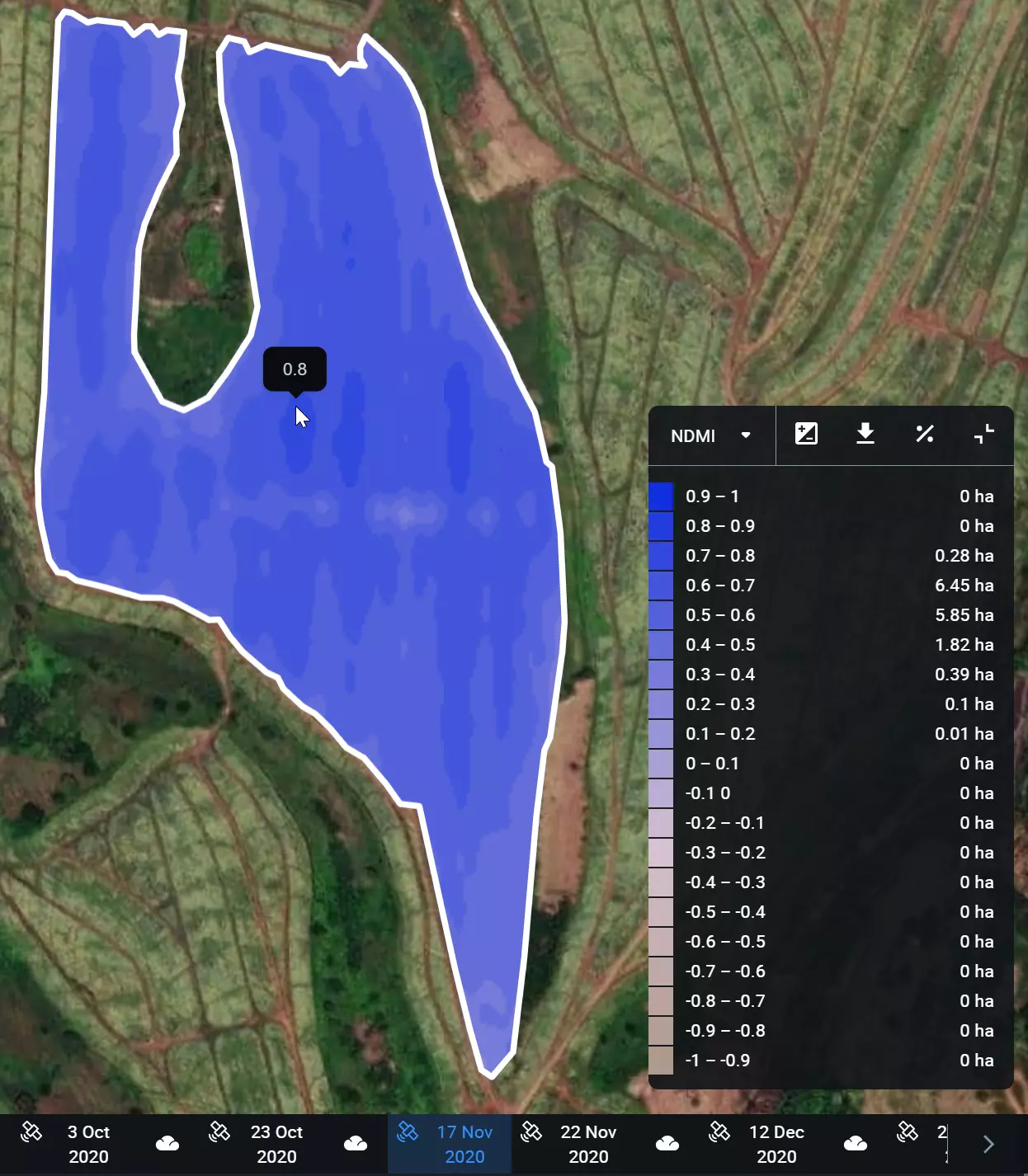NDMI (Normalized Difference Moisture Index)
The Normalized Difference Moisture Index (NDMI) detects moisture levels in vegetation using a combination of near-infrared (NIR) and short-wave infrared (SWIR) spectral bands. It is a reliable indicator of water stress in crops.
Severe drought conditions not only stress the crops but can destroy the entire yield. NDMI can detect water stress at an early stage, before the problem has gone out of hand. Further, using NDMI to monitor irrigation, especially in areas where crops require more water than nature can supply, helps to significantly improve crop growth. All of this makes NDMI an excellent farm tool. And since dry conditions in fire-prone areas increase the risk of combustion, NDMI has yet another application: fuel levels monitoring.
Although colloquially NDMI is often compared with the NDWI index, the two should be effectively viewed as different indices. While NDMI and Gao’s version of NDWI use the NIR-SWIR combination to detect moisture content in leaves, the McFeeters’s NDWI uses the GREEN-NIR combination to highlight water bodies and monitor their turbidity. So, to avoid any confusion, NDMI uses a NIR-short-wave infrared band combination and should be treated as a separate index from the NDWI that measures water content of water bodies.
NDMI Formula
NDMI is calculated using the near-infrared (NIR) and the short-wave infrared (SWIR) reflectance:
NDMI = (NIR – SWIR) / (NIR + SWIR)
- Sentinel-2:
NDMI = (B08 – B11)/(B08 + B11)
- Landsat 4-5 TM:
NDMI = (B04 – B05) / (B04 + B05)
- Landsat 7 ETM+:
NDMI = (B04 – B05) / (B04 + B05)
- Landsat 8:
NDMI = (B05 – B06) / (B05 + B06)
- MODIS:
NDMI = (B02 – B06) / (B02 + B06)
The NIR and SWIR bands were selected for the NDMI band equation to mitigate the effects of illumination and atmosphere. The short-wave infrared spectral channel (SWIR) is sensitive to the vegetation water content and the mesophyll structure of leaves. On the other hand, the near-infrared band (NIR) picks up the bright reflectance off the leaf internal structure and leaf dry matter content. When combined, the accuracy of data on the vegetation water content becomes much higher. Additionally, NDMI is a better deforestation indicator than NDVI thanks to a less abrupt decrease in values.
Interpretation Of NDMI values
Like most indices, NDMI can only have values between -1 and 1, which makes it very easy to interpret. Water stress would be signalled by the negative values approaching -1, while the +1 may indicate waterlogging. Therefore every value in between will correspond to a slightly different agronomic situation.
- -1 – -0.8 Bare soil,
- -0.8 – -0.6 Almost absent canopy cover,
- -0.6 – -0.4 Very low canopy cover,
- -0.4 – -0.2 Low canopy cover, dry or very low canopy cover, wet,
- -0.2 – 0 Mid-low canopy cover, high water stress or low canopy cover, low water stress,
- 0 – 0.2 Average canopy cover, high water stress or mid-low canopy cover, low water stress,
- 0.2 – 0.4 Mid-high canopy cover, high water stress or average canopy cover, low water stress,
- 0.4 – 0.6 High canopy cover, no water stress,
- 0.6 – 0.8 Very high canopy cover, no water stress,
- 0.8 – 1 Total canopy cover, no water stress/waterlogging
It is important to keep in mind that NDMI values vary throughout the growing season because the plants’ reflectance is slightly different for every phenological stage. There also exists an interesting correlation between NDMI and NDVI. Water stress indicated by the NDMI values can be confirmed by a significantly lower than average NDVI.
When Is It Used?
The Normalized Difference Moisture Index can be used to:
- Regularly monitor water content in crops,
- Determine field/farm zones with water stress,
- Improve tree harvest logistics planning,
- Determine the combustibility levels in fire-prone areas.
Visualization Of NDMI
The two common ways to visualize NDMI values are maps and graphs. A map vividly shows the spatial distribution of water stress across the field(s), while a graph demonstrates its evolution over time.
The NDMI range is -1 to +1, where the lowest values (white to pale brown) indicate low vegetation water content, and the highest ones (in blue) correspond to high water content. In other words, decrease in NDMI will indicate water stress, while abnormally high NDMI values could signal waterlogging.
- On this screenshot, you can see two images of the same field taken 2 years apart, illustrating variations of NDMI values. Image on the left shows no signs of water stress, while image on the right reveals stressed crops after a prolonged period of unusually low precipitation in 2021.

- The field in this image seems to have some of its areas waterlogged as a result of recent heavy rains. Water has nowhere to escape in these areas, so it collects in pools. Waterlogging is a problem since it significantly reduces crop yield.

It is therefore possible to detect waterlogged areas within a field using NDMI, solve the problem and prevent it in the future.